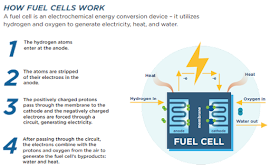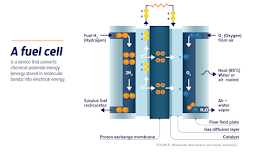The global hydrogen fuel cells market size is expected to be worth around US$ 131.06 billion by 2030 from at US$ 1.91 billion in 2021, growing at a CAGR of 60.1% during the forecast period 2022 to 2030.
Growth Factors
The onboard electric motor of a hydrogen-fuel cell automobile is powered by hydrogen fuel cells. Hydrogen is used to power a hydrogen fuel cell. Hydrogen fuel cell vehicles have a great deal of potential for reducing emissions in the transportation sector. Unlike diesel and gasoline automobiles, this vehicle produces no greenhouse gas emissions during operation. In order to function, hydrogen fuel cells require a constant supply of oxygen and fuel. A fuel cell is a device that utilizes compound reactions to assist in the generation of electrical force.
The increased environmental concerns, increased government initiatives for the construction of hydrogen fuel cells infrastructure, expensive initial infrastructure investment, and technology advancement are all significant factors influencing the growth of the global hydrogen fuel cells market. During the forecast period, each of these variables is expected to have a significant impact on the hydrogen fuel cells market.
The global use of hydrogen fuel cell recharging stations is enhancing the hydrogen fuel cell’s viability as an alternative vehicle propulsion system. The high-growth companies invest a small amount of money in manufacturing, designing, executing fuel cell projects, operating, installing, and managing large-scale fuel cell systems, servicing, and manual power control to build a strong strategic business model that will expand the applicability of the hydrogen fuel cells make it capable of replacing conventional sources of energy.
Scope of the Hydrogen Fuel Cells Market
As environmental concerns grow, manufacturers are focusing their efforts on the hydrogen economy. The scalability is another benefit of hydrogen fuel cells. They can be used to build stacks, which can then be used to build larger systems. The portable systems for smartphone battery recharging, combustion engine replacements for electric vehicles, and large-scale installations directly feeding electricity into the utility grid are all examples of these systems, which range in power and size.
The market for hydrogen fuel cells is being driven by the growing demand for electric vehicles. The use of electric vehicles has drawn the attention of the government due to an increase in carbon emissions. Another element influencing the industry is the increased environmental awareness. The environmental issues have arisen as a result of the over exploitation of fossil resources, which has resulted in harmful gas emissions. The hydrogen fuel cells market’s demand is being driven by the desire to minimize reliance on diesel and oil.
The automobile sector has experienced remarkable expansion as a result of rising vehicle demand. However, in recent years, there has been a growing awareness and issue about the negative environmental impact of fossil fuel engines, which produce considerable amounts of greenhouse gases. Over the projected period, this is expected to assist the expansion of the hydrogen fuel cells market. Other reasons such as technical improvements, higher performance, rising petroleum prices, reduced noise, and stringent government regulations regarding environmental conservation are also predicted to contribute to the hydrogen fuel cells market’s growth during the forecast period.
Technology Insights
In 2020, the proton exchange membrane fuel cells segment dominated the market for hydrogen fuel cells. The widespread use of proton exchange membrane fuel cells in fixed, transit, and portable applications has resulted in a sizable market share.
In 2020, the solid oxide fuel cell segment will be the fastest growing segment of the hydrogen fuel cell market. Because solid oxide fuel cells can operate at high temperatures, expensive catalysts such as ruthenium are no longer required. The most common application for solid oxide fuel cells is in stationary applications.
Application Insights
In 2020, the stationary segment dominated the hydrogen fuel cells market. The stationary segment is expected to become the most popular application during the forecast period. Because of factors such as high efficiency and the ability to use a variety of fuels, the stationary application segment is expected to grow.
The transportation sector, on the other hand, is expected to grow at the fastest rate in the coming years. The transportation application segment is expected to grow at arapid pace during the forecast period due to rising demand for hydrogen fuel cell automobiles and hydrogen fuel cell powered forklifts. Furthermore, the industry is expected to expand as a result of increased research and development activities in developed and developing countries to produce hydrogen-powered hybrid vehicles.
Region Insights
North America dominated the hydrogen fuel cells market in 2020. The fuel cell deployments in North American countries have been aided by research and development programs, as well as incentives and subsidies provided by government for fuel cell-based vehicles, as well as funding and expenditure by governments, which have pushed the use of fuel cell and hydrogen technologies in the North America region.
Asia-Pacific, on the other hand, is expected to develop at the fastest rate during the forecast period. The region’s expanding population and rising disposable income are lifting up the demand for energy. Furthermore, the region’s rapidly growing economies are also the world’s leading polluters. The hydrogen fuel cells have been found as the best alternative to other conventional fossil fuel energy sources for reducing carbon emissions and efficiently providing energy needs.
Key Developments
SGH2, a global energy firm based in Washington DC, revealed in May 2020 that they are intending to build a massive green hydrogen manufacturing plant in California. The plant is expected to be completely operational by the year 2023.
United Hydrogen Group Inc. and Giner ELX were acquired by Plug Power Inc., a leading provider of hydrogen cell engines and fueling systems that enable e-mobility, in June 2020. These two purchases by the company are in keeping with Plug Power’s vertical integration strategy in the hydrogen market, with the goal of having more than 50% of the hydrogen utilized green by 2024.
Cummins Inc., based in Ohio, announced plans to buy Hydrogenics Corporation, a Toronto-based hydrogen fuel cells manufacturer in June 2020.
The global market for hydrogen fuel cells is highly fragmented, with only a few firms competing with each other. However, due to the market’s competitiveness, the number of new companies is likely to enter the hydrogen fuel cells market in the near future is expected to increase. The leading organizations engage in research and development in order to stay competitive and produce new products.










0 Comments